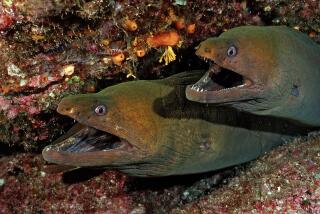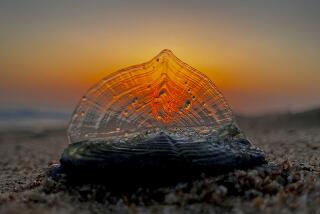Man-of-war invading South Florida shoreline
- Share via
Reporting from Fort Lauderdale, Fla. — Riding the wind and ocean currents, hordes of blue, alien-like creatures have descended upon South Florida’s shoreline, entangling beachgoers in poisonous tentacles and delivering painful stings by the hundreds.
Each invader, in fact, isn’t an “it” but a “they” — a colony of organisms that combine to create a single entity, the Portuguese man-of-war. The seafaring wanderer with the neon-blue gas bag and tentacles as long as 30 feet seems more suited to a sci-fi horror flick than a sunny tourist beach.
But in Florida, its appearance is a yearly, if painful, ritual. The man-of-war visits every winter and early spring, driven onshore by southeasterly winds and the Gulf Stream’s current. But this year’s swarm arrived in far greater numbers than usual.
“It was unbelievable,” said Crystal Haire, a lifeguard with Fort Lauderdale Ocean Rescue. “I’ve never seen that many at once. The shoreline was blue.”
Hundreds of beachgoers sought treatment for stings this week. Fort Lauderdale lifeguards treated 122 victims on Sunday. Delray Beach lifeguards tended to 197 stings.
“There were just so many coming in all at once; it was rare, the numbers we had,” said James Scala, superintendent of Delray Beach Ocean Rescue. The man-of-war injuries fell Monday — 25 in Fort Lauderdale, about 50 in Delray — because there were fewer people on the beaches.
The man-of-war, or Physalia physalis, is bobbing testimony to nature’s imagination. It is also known as the bluebottle for the azure bladder that keeps it on the surface. It is not a jellyfish, which is far more common.
“The Portuguese man-of-war is an oddball,” said Charles Messing, professor of marine biology at Nova Southeastern University. “It’s a bizarre thing.”
Take that bladder: It’s full of gas, mostly nitrogen, but 13% carbon monoxide. The crest atop the bladder catches the wind, propelling the creature across the sea. The crest also may have account for its name; it resembles an old warship, or man-of-war, at full sail.
And the bladder can deflate when Physalia decides to submerge — though it can’t really “decide” because it doesn’t have a brain, only a network of nerves.
The man-of-war likes warm ocean water and sometimes travels in groups of 1,000 or more. Tendrils can detach and sting swimmers, and their poison remains active for more than a week after they are severed from the main body, or even after the creature is dead.
To eat, the man-of-war trails tentacles in the sea, ensnaring small fish and crustaceans. The venom-filled tendrils paralyze prey and pull it into multiple mouths. Because the man-of-war doesn’t have a “backside,” waste must go out the same way food comes in.
Shifting winds are sending the invaders on their way, although parts of the beaches remain covered in blue.
The man-of-war wasn’t the only strange visitor to Delray’s beach this week. A 3-foot squid washed ashore, squirting ink by the cupful and sending beachgoers on a rescue mission.
The orange-and-maroon cephalopod, with its football-size head and muscular tentacles, was difficult to grip, so rescuers placed it in a cooler and walked it out to sea.
More to Read
Sign up for Essential California
The most important California stories and recommendations in your inbox every morning.
You may occasionally receive promotional content from the Los Angeles Times.













